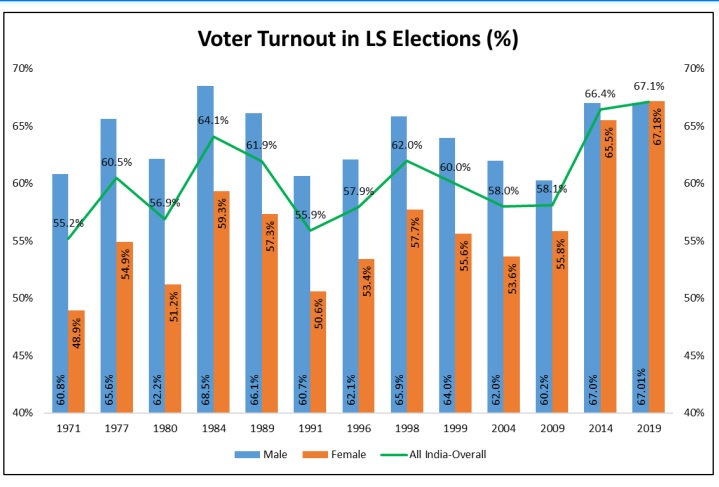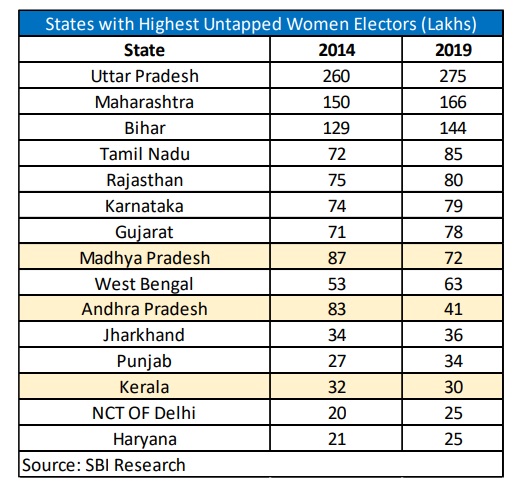How the narrative has decisively changed from “Missing Women” to “Women-in-the-Middle” in the last decade


Dr. Soumya Kanti Ghosh
Group Chief Economic Adviser
State Bank of India
Mumbai, April 17, 2024: With 60+ nations slated to undergo the electoral process involving close to a quarter of the global population, 2024 is truly dubbed the Year of Elections whose ramifications on local economies are expected to transcend boundaries, shaping the trans border geo-political contours through a mélange of bold signals and sublime messages through years to come
❑ The elections in two of the largest economies, and democracies; India and the USA hold special interest for the common person, as unbridled, low-priced access to 24*7 information, coupled with feverish and sticky engagement with social media platforms ensure the ensuing ballot exercise has a neural connect for an overwhelming proportion of populace, both pre and post poll stage, often escaping the radar of even the battle hardened Psephologists. Amidst the cacophony and clutter of the referendum, we endeavor to find the footprints of big change
❑ The socio-cultural diversity of many large India states, juxtaposed smoothly against some of the large countries on population terms, implies the intended benefits of reforms is percolating down to the intended classes over a period of time
Representative Share Of Women
❑ The Lok Sabha, or the lower house of the parliament with 543 seats for which elections are held, commands highest population per seat among major economies, though the representative share of women falls drastically, in line with trend observed amongst developing economies. Interestingly, the current voter turnaround (%) gels well with AEs though. Currently, 15% of the total members of the 17th Lok Sabha are women (5% in the first Lok Sabha) while in state legislative assemblies, women on average constitute 9% of the total members
❑ There has been a constant upward trend in the registration of women voters, with the gender ratio now 948, up from 928 in 2019, with men accounting for 49.7 crore voters compared to 47.1 crore women (registered). This year, there are 12 states with a gender ratio more than 1,000 as compared to 8 states in 2019. Women also account for 85.3 lakh first-time voters (within 1.8 crore total such voters)
Rise In Women Voter Turnout
❑ Rising participation of women in India’s political arena is one of the most significant stories of the last decade. Women voters are now playing a significantly bigger role in elections than ever before. In the 2019 General Lok Sabha elections, female voter turnout rates was higher than males, which has been declining from 1991, when the gap was more than 10%. The gap was stagnant at around 8.4% on an average for 4 elections between 1996 and 2004
❑ The rise in women voter turnout has been even more pronounced in State Assembly elections. Out of the 23-major States, where state assembly elections happened in last 5-years, indicate that women’s turnout was higher than that of men in 18 States. Interestingly, out of these 18 states, same Government was re-elected in 10 states, where women turnout was more than men turnout
❑ Significantly, even as women are voting in significantly large numbers there is still an untapped potential of registered women voters who may have not voted …For example, untapped women voter base are not reaching to polling booths chiefly in states like UP, Maharashtra, Bihar, Tamil Nadu, and Rajasthan…..We believe 2024 could be the bellwether If a portion of these women could be made an innate part of the polling exercise progressively, the electoral outcome may witness marked changes…Our estimates suggest that up to 13 crore more women could thus vote in the 2024 elections in addition to 33 crores women voters that might vote in 2024…This could potentially turn out to be game changer in 2024 elections and onwards…
Economic Upliftment Break Taboos
❑ In India, the narrative till a few decades back used to be centered around “Missing Women”….We are pleasantly surprised that it has now been successfully moulded to “Women-In-The-Middle” approach as better education, rising awareness and economic upliftment break taboos empowering the equal half in decision making
Women are wielding more deciding factor of electoral outcome in States like Kerala, Goa, Tamil Nadu, Andhra Pradesh, and Chhattisgarh…In future, Women are expected to be the deciding factor of electoral outcome in Telangana, Himachal Pradesh, Karnataka, and Sikkim ❑ Analyzing the contours of past voting percentage and the behavioral shift underway, we project total voter turnout at the current rate of polling could touch 68 crores in 2024, of which women voters could be at 33 crores /49%....Further, in 2029, we project total voter turnout at the current rate of polling could touch 73 crores, of which women voters at 37 crores could be outstripping registered men voters at 36 crores/ >50% of registered voters…..the inflection point would be a testimony of women getting their due share on socioeconomic fronts and should be a harbinger of harmonized socio-economic growth….
2047 Projections
❑ Our study indicates that in 2047 (probable election year 2049), women voter turnout should increase to 55% and men voter turnout might fall to 45%....In 2047 it is projected that around 115 crore people would be registered electors with nearly same proportion of men and women though in 2047, voter turnout would be at 80% i.e around 92 crore people. Voter turnout will have more participation of women than men with 50.6 crore women, and 41.4 crore men signifying tectonic shift of electoral participation in India
❑ With the passage of the 106th amendment to the constitution paving the way for 1/3 rd reservation for women in Lok Sabha/State Legislative assemblies, the representation of women in the highest forums of policy making should reach a pivot, which will be evident in number of women contestants fielded by major political parties….when compared women contestants across National parties, BJP has fielded the maximum number of women contestants in India, followed by INC
With the women’s share increasing in all the Government sponsored schemes (share of women stands at 81% in Stand-up India, 68% in MUDRA loans, 37% in PMSBY and 27% in PMJJBY), among the Major States such as Gujarat, Karnataka, MP, Punjab, Rajasthan, UP, Chhattisgarh, Uttarakhand, and Telangana, women electoral participation is increasing with rising number of Women PMJDY accounts and Women Mudra Loan Accounts benefits reaching new grounds
❑ This could be the antidote to ‘freebies led’ campaigns and promises by select dispensations ❑ The recent concluded state elections point to a growing realism that voters do not prefer freebees, rather demanding tangible development outcomes. The last two general election show that economics plays a major role in attracting voters. This year’s election manifestos have accordingly targeted major economic challenges such as growth, trade, social security etc
❑ States like Himachal Pradesh, Delhi, Haryana, Rajasthan, and Gujarat have displayed strong one-sided sentiment in Lok Sabha seats, for the party of their choice, which draws more voter turnout, and results into a one-sided fight for winning with very high margin….the Political parties on the receiving end may have to work very hard to generate a sentiment in Lok Sabha seats across these states for winning….swing votes would also be instrumental in determining the outcomes on many high voltage seats as also on seats with ultra low winning margins